Preserving What Came Before


The mask I'm wearing is my super-nasty-needed-changed-out-six-months-ago sandblasting mask. I’m using that one because if the window was puttied into the frame using lead-based putty - which isn't all that uncommon with pieces this age – I don't end up with a lungful of lead dust.
The funny thing about respirator style masks is that the dirtier they get, generally, the better they work. This one though is well beyond its prime, so, I had no qualms using this one for lead dust instead of the silica dust produced by my normal glass fare. This job is my first relead in quite awhile, so I'll end up tossing the mask afterwards.
I used to do restoration of stained glass windows for a living, way back before opening my own studio. Restoration is somewhat dangerous beyond the matter of lead dust – old pieces of glass are sharp, aged putty is sharp, and you're using a lot of sharp tools with a good deal of force behind them to deconstruct the window and clean it. Those kinds of jobs are a bit like flying an airplane: any landing without blood is a good day.
What's the difference between a relead and a restoration? A relead is almost always part of a restoration, but a true restoration is filled with compromises.
The goal is to walk a fine line and keep the window at its most authentic, given its historical importance, by also ensuring that your work is not only going to last a long time, but is also done so that the next restorer can easily undo it if new techniques are discovered between your restoration and the next go-round, in 80-150 years from now.
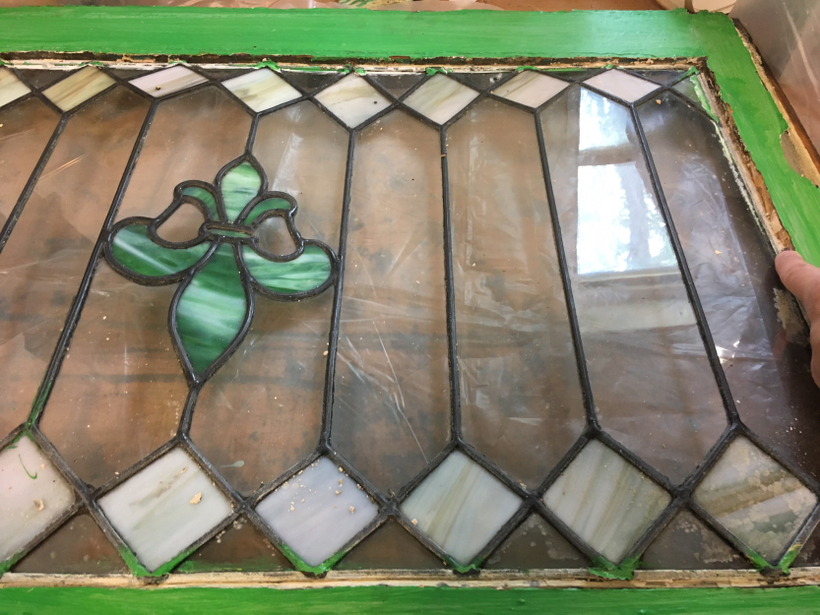
This job is strictly a relead. My client doesn't know the provenance of the window; they bought it presumably in an antique store or somewhere similar because they liked the look of it. (Photo above). Because it uses fairly pedestrian glass from the Victorian era, the origin is unknown, and it is super warped and bulging, I'm making some changes to it in order to make it last longer before it needs another releading.
For starters, a window of this size should have a stabilizing bar soldered or wired to the panel across the midsection. The panel has narrow lead too, which may have been chosen because it was the fashion in much of the opalescent era.
Anything over about a 2' x 2' panel should have a stabilizing bar if it's leaded rather than copper foiled, especially given that the size of the long clear hexagons is pretty close to criminal.
It’s close to criminal because any piece that size with such a narrow width is more likely to break. That’s due to the gravity-induced stressors on a window over time, especially when the window has no proper stabilizing bar to help maintain its good posture. Lead is inelastic, so once it bends out of true (again, due to gravity over time) the only thing holding the window vertically becomes the glass. Combined with the narrow lead? Hell no.
Since there was a bit of overlap between the Victorian era in stained glass and World War I (where lead was needed for bullets and stained glass window lead tends to be narrower during that era as a result), it's tough to say why that particular width of lead was chosen. It wasn't a great idea for this window though, given the size and scope of the clear hexagons.
The window definitely isn't any older than about the 1880's, because opalescent glass didn't exist until Tiffany (or LaFarge) invented it around that time. In my opinion, any window in the United States that predates the opalescent era should err more on the side of restoration than a mere releading, since windows prior to that era are rare and often European in origin.
This window is quite common in style and size to the windows that were put into lots of industrial era houses in many cities east of the Mississippi. At the turn of the century, a glazier’s labor was cheaper than big sheets of clear glass (or so I've been told), and with the size of the pieces involved, a good glazier could have put it together in a few hours, which also tells me it isn’t a window with a valuable origin.
So a window using both clear and opalescent glass plus a design that doesn't scream Victorian, but has narrower lead than I would feel comfortable using? With those clues, I’d guess it probably dates from somewhere between right after WWI through 1929, when the Great Depression hit.
But that's mere speculation on my part, and probably further down the geek rabbit hole than I really need to stray. So without further ado, let's talk releading.
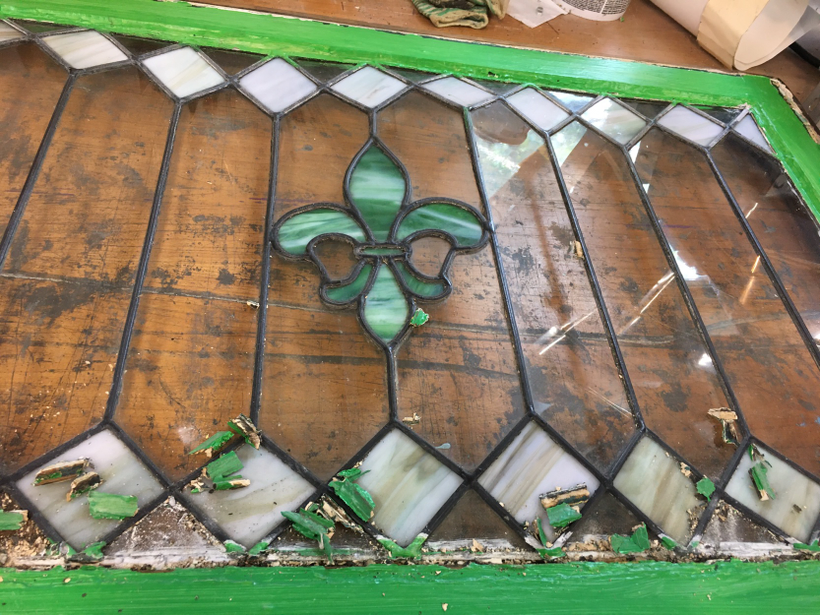
Step one involves using a hammer and chisel to very carefully chip away all of the old putty out of the frame. I've started this process in the photo above.
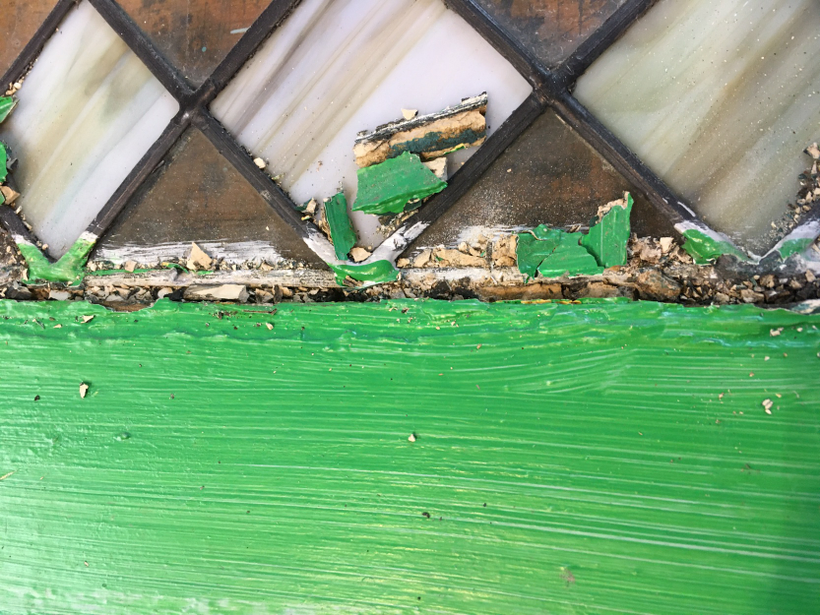
Step two is finding whatever retaining method the installer used in addition to putty to hold the window into the frame. In this case, they used a tiny nail similar to a carpet tack, which you can see in the photo below. Luckily, they pulled free fairly easily once I found them all.
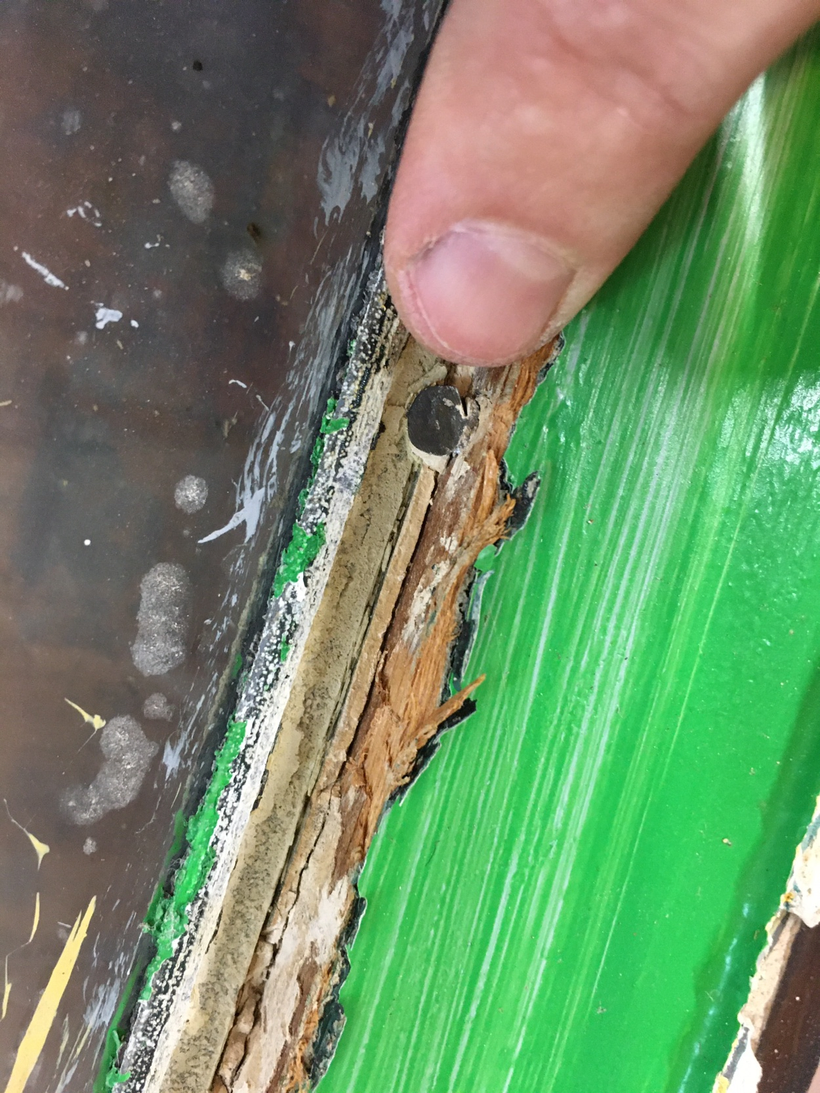
Every studio had their own closely-guarded putty recipe like Venetian glass blowing techniques or certain soda formulas. Sometimes, they used a lead-based putty with either white lead or red lead as one of the main ingredients. Lead putty holds really well (or badly) depending on whether you're the homeowner needing the putty seal to last or the restorer grumbling because they cannot disengage the putty bead from the frame without some gouging damage to the wood. I was grumbling a lot, which means I'm glad I was wearing my mask.
Lead putty is also one of the reasons I have HEPA grade filters in both shop vacs. The easiest way to clean all of the putty (and its ensuing dust) off the window after chipping it away is with a shop vac.
One of the other issues that Victorian windows tend to have is that they were built too big about 90% of the time.
You can see in the photo below how badly this window is bulged and wavy, and what we've learned from years of doing this is that the windows are best sized "close", and then allowed to float a little within the frame. Chances are I'll have to cut the edge pieces down a wee bit to ensure the stained glass panel can easily be dropped back into the frame after I rebuild it.
The third step is documented in the video. It's probably the most fear-inducing part of the process: sliding the window out of the frame, and not knowing if the lead is still in good enough shape to keep it from accordion folding in on itself, and you with only one hand to catch it. Luckily this one was bad, but not yet at "complete lead failure" range.

So above is the window in all of its warped glory, removed from the frame and ready to be torn apart and cleaned. Typically, the next step after this would be to make a rubbing of it (just like with a gravestone) but this window is too badly warped to be able to do so. The photo below is a rubbing of a different relead job, but you can see that the lines are a lot smudgier than a freshly-drawn cartoon for new work.
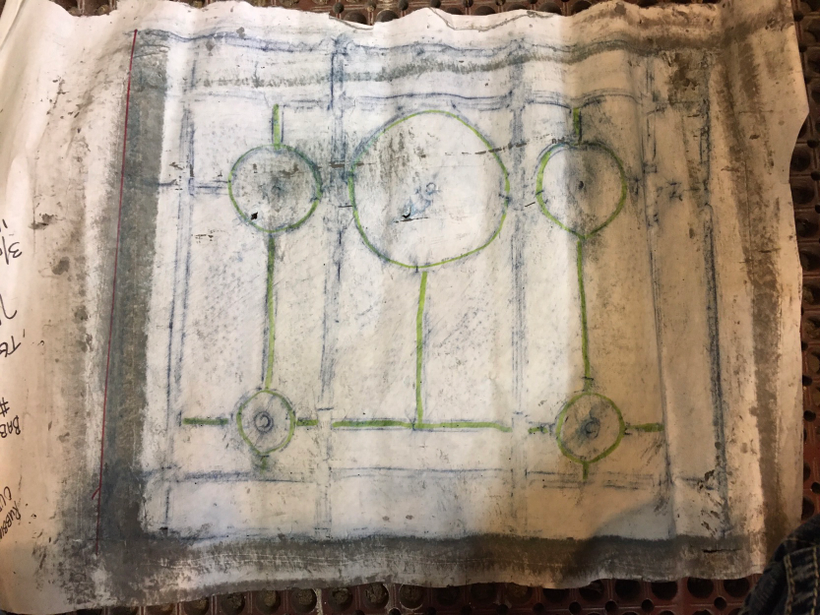
Sometimes a window can be gently flattened after it has been sprayed down with water to loosen the putty, but this window is simple enough (and those damn hexagons are big and skinny enough) that I opted simply to draw a rectangle of an appropriate size, using the frame opening as a guide. That’s also the second reason a rubbing is generally done, especially on non-geometric windows. Then, while you’re glazing it, there's a guideline of where the non-linear bits should land.
Step five is to wet the window down and let it sit for a bit. (That's why I have it laid on plastic.) This cuts down on the lead dust in the air as it gets disassembled, and also helps to soften the putty. That allows the pieces to come out of the lead housing a little easier.
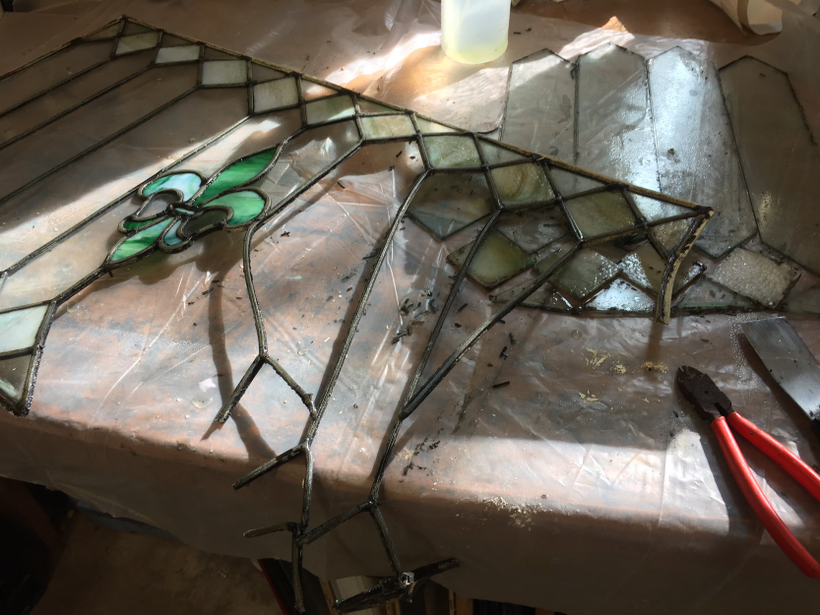
Step six is the actual disassembly, as the photo above shows. Sometimes a second rubbing is made - especially for a complicated window. It can be necessary to lay it out on the rubbing so that you don’t get all jumbled up with what went where. Keeping things laid out where they went (even though there's not many pieces in this window) is as important with geometric windows as complicated swirly windows.
Even though any geometric shape is generally gauge cut – meaning each hexagon should be interchangeable with another hexagon, squares with squares, and so on, that's rarely the case in relead work. Even if they were originally the same, remember what I said about bulging and waving of the glass?
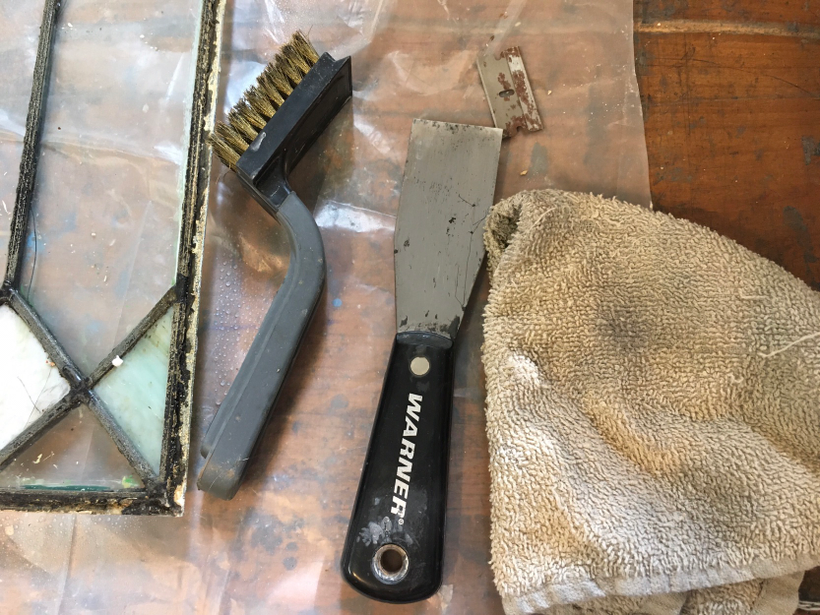
Each piece is soaked in a mixture of Simple Green cleaner and the hottest water possible. I use a razor scraper to pry off the old putty and dirt, and, if need be, each piece is scrubbed with things of varying stiffness. I generally start with a washcloth and use a brass brush on the tough parts.
Then the window gets put back together with entirely new lead. Since this one lacks a stabilization bar, it would be foolish to attach it to several single vertical leads. The best placement for bars is on intersections of lead, and since this window wasn't designed with those in mind, I plan to cut some of the hexagons in half to provide me with intersections enough to make the bar last until the next relead.
That's the type of decision that - were this a restoration on a historically notable window - most restorers would be loathe to make.
That decision permanently alters the window, yet the window clearly needs the addition of a bar in order to give it the longest lease on life possible...
The final step is weatherproofing the window, adding the bar, and putting the window back into the frame.
However, the frame is in pretty tough aesthetic shape, and my woodworking skills are amateur at best, so I outlined in the contract that my particular involvement with this window covered a relead only, and that hands more skilled than mine were needed to restore the frame back into any semblance of glory. So I'll be delivering this attached to a sheet of plywood so that it can be kept upright until the frame is fixed up, and it can be reinstalled.
I hope this was an interesting peek into something I don't often do within my studio anymore. I mostly avoid releads (or restoration) when possible simply because they create a lot of hazardous dust and dirt, and I don't enjoy doing them.
I do them as needed because I think it would be somewhat hypocritical to be putting so much stained glass out in the world if I never did any maintenance or upkeep on the stained glass of those hands which have come before me.
It's a little like lighting a stick of incense to one's ancestors, I guess.
Thank you for reading, and thank you to my patrons for helping me be able to do this kind of work through supporting me on Patreon. For as little as $3 a month, patrons get to see more of what goes on in my studio with weekly updates like this, help my work improve even more, and get cool annual rewards. It’s easy to sign up at patreon.com/MSotherden, so don't wait!




